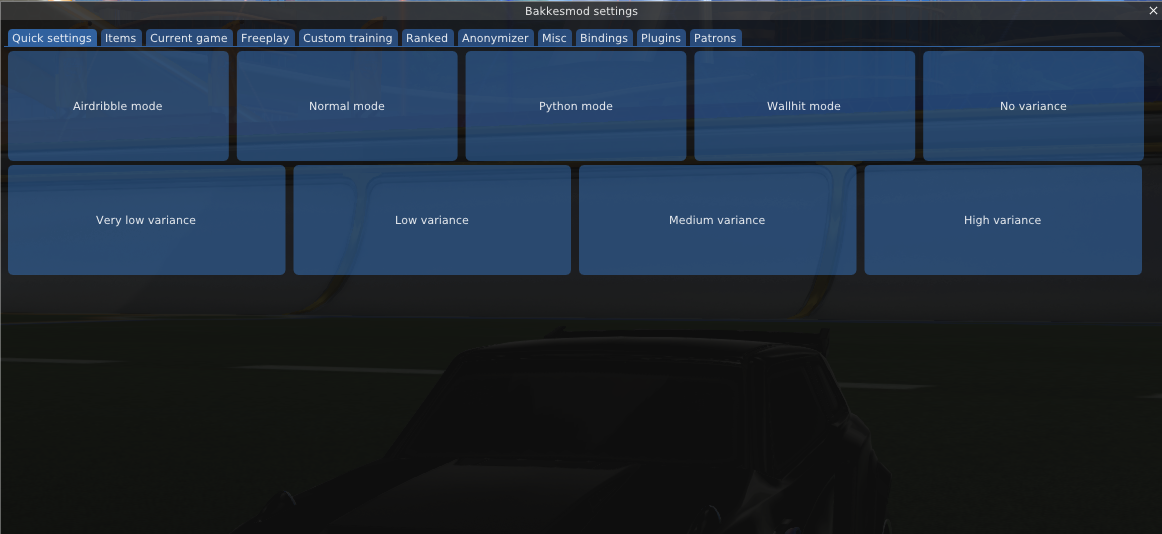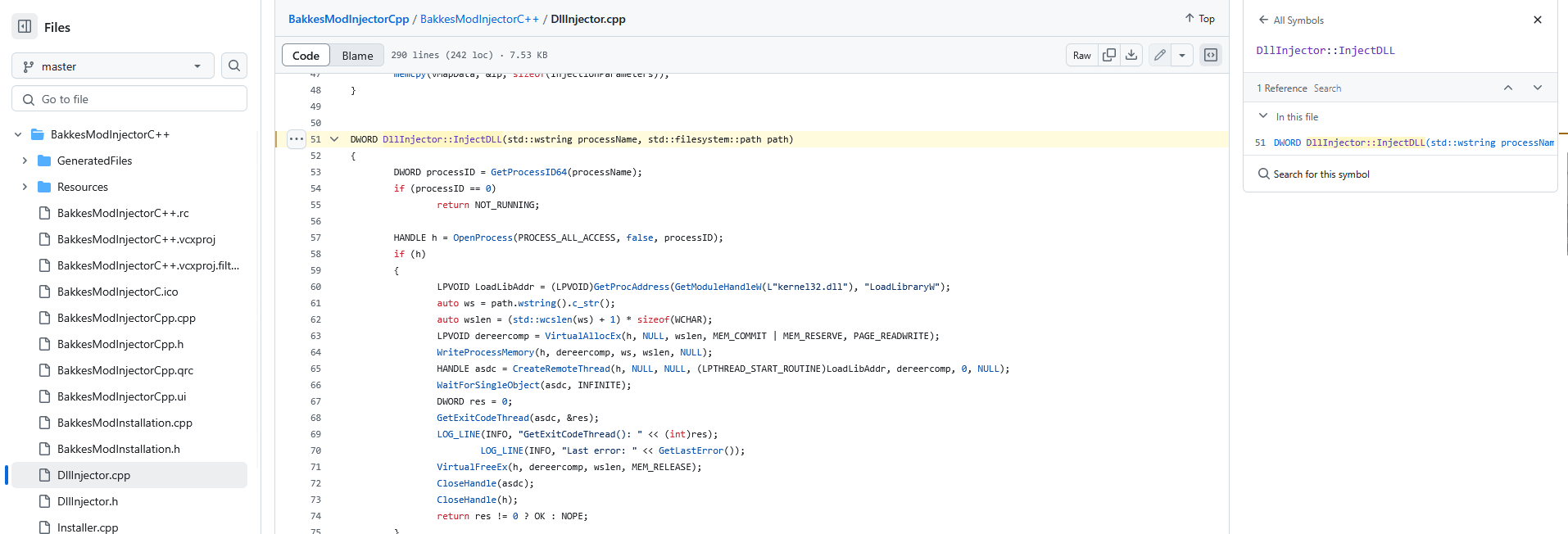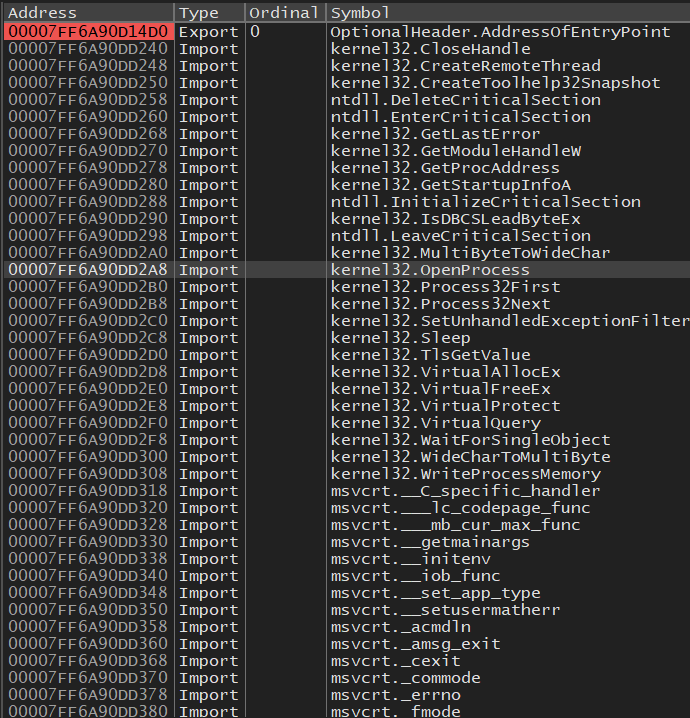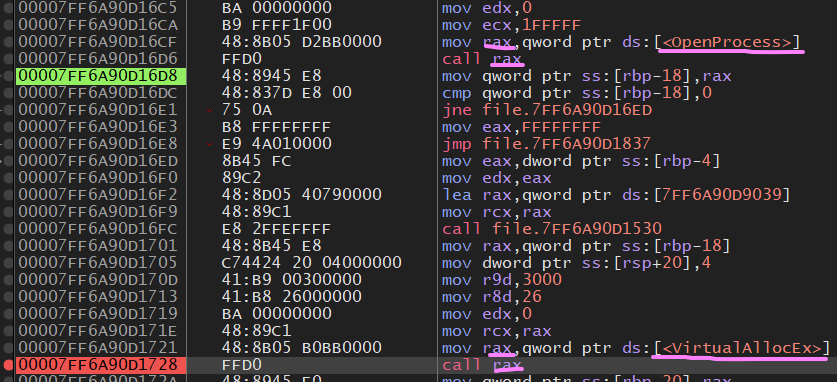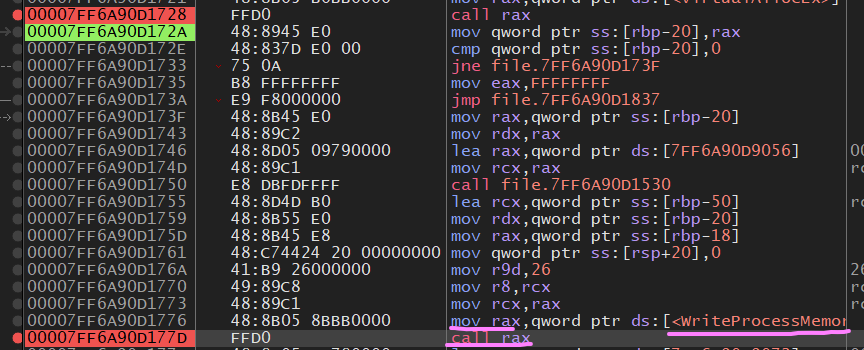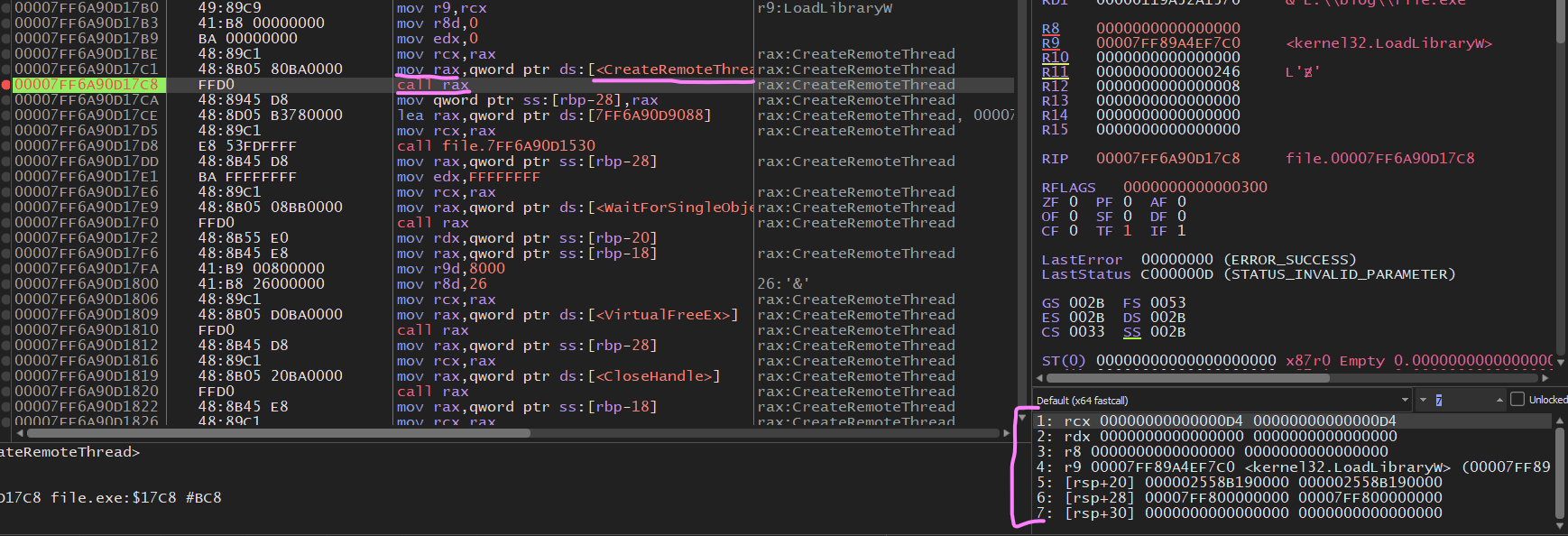3. Game Hacking - BakkesMod
Intro
So i’ve been playing rocket league for as long as I can remember, and I have this mod called BakkesMod. I have BakkesMod to use skins I don’t have unlocked, you can basically call it a “skin changer” with one caveat, you can only see the skins client side. On the other hand it has loads of functionality.
It was only a matter of time before I thought to myself “How does this even work?” so I did what anyone else in the world would do, and that was go to their github repo :).
The Injectahhhhh
Upon visiting their profile I see many interesting repos but one catches my eye.
https://github.com/bakkesmodorg/BakkesModInjectorCpp
This is the code for their DLL Injector, i.e place an arbitrary DLL inside the address space of another (remote) process. Once that DLL is inside of the remote process it creates a remote thread to call DllMain of the DLL that was injected, once DllMain is called execution starts and BakkesMod can do it’s thing.
DLL Injection is not a new technique, it’s a widely known technique to get code to run inside of another process. Sometimes malware and cheats use DLL Injection to setup for things like hooking because once their DLL is loaded into the target process it has access to the memory of that target process as well, meaning it can manipulate the functionality of the process while it’s running which is a big win for someone who wants to do so.
Sidenote: (BakkesMod is considered a “Mod” not a “Cheat” hence the name, it does not give an unfair advantage)
Here’s a code snippet from ired-team demonstrating DLL Injection
int main(int argc, char *argv[]) {
HANDLE processHandle;
PVOID remoteBuffer;
wchar_t dllPath[] = TEXT("C:\\experiments\\evilm64.dll");
printf("Injecting DLL to PID: %i\n", atoi(argv[1]));
processHandle = OpenProcess(PROCESS_ALL_ACCESS, FALSE, DWORD(atoi(argv[1])));
remoteBuffer = VirtualAllocEx(processHandle, NULL, sizeof dllPath, MEM_COMMIT, PAGE_READWRITE);
WriteProcessMemory(processHandle, remoteBuffer, (LPVOID)dllPath, sizeof dllPath, NULL);
PTHREAD_START_ROUTINE threatStartRoutineAddress = (PTHREAD_START_ROUTINE)GetProcAddress(GetModuleHandle(TEXT("Kernel32")), "LoadLibraryW");
CreateRemoteThread(processHandle, NULL, 0, threatStartRoutineAddress, remoteBuffer, 0, NULL);
CloseHandle(processHandle);
return 0;
}
Now that we know BakkesMod does DLL Injection we should be looking for these function calls inside the code
OpenProcessWriteProcessMemoryVirtualAllocExVirtualProtect(maybe)CreateRemoteThread
Looking around you’ll see a couple files but one should stick out like a sore thumb, DllInjector.cpp In this file you’ll find a function called InjectDLL
This function takes in a std::wstring processName which would most likely be RocketLeague.exe and a std::filesystem::path path which would most likely be the path to the DLL to be injected. Inside the function we can see it’s doing the same exact thing we saw from ired-team’s demonstration,
the order of the functions are a little different but they both serve the same purpose and that’s Injecting a DLL into a remote process.
On lines 57-60
after it has a valid handle to the process it locates the address of LoadLibraryW using GetProcAddress
This is also done in ired-team’s demonstration here
PTHREAD_START_ROUTINE threatStartRoutineAddress = (PTHREAD_START_ROUTINE)GetProcAddress(GetModuleHandle(TEXT("Kernel32")), "LoadLibraryW");
Lines 61-64
handle allocating memory for the library name string and writing that to the allocation.
65-77 is where CreateRemoteThread is called to start execution, after execution has started BakkesMod waits and then does some cleanup.
looking at the CreateRemoteThread
and LoadLibraryW
documentation on msdn helps understand what’s going on.
HMODULE LoadLibraryW(
[in] LPCWSTR lpLibFileName
);
LoadLibraryW takes in one parameter, a pointer to a widechar string
that is the name of a DLL to be loaded.
HANDLE CreateRemoteThread(
[in] HANDLE hProcess,
[in] LPSECURITY_ATTRIBUTES lpThreadAttributes,
[in] SIZE_T dwStackSize,
[in] LPTHREAD_START_ROUTINE lpStartAddress,
[in] LPVOID lpParameter,
[in] DWORD dwCreationFlags,
[out] LPDWORD lpThreadId
);
In our case lpStartAddress is the address of LoadLibraryW and lpParameter is dereercomp which
is a pointer to the name of the DLL to be loaded. So a thread will be created and once it starts LoadLibraryW
will execute with whatever string is held at the memory of dereercomp.
Gettin’ dirty
With all this information idk about you but this makes me wan’t to write my own DLL Injector, let’s get to it.
First we’ll start with finding the process ID of rocket league, this is a special number the OS uses to identify a process.
We need it to tell OpenProcess what process we wan’t a handle to.
Here’s my code to find the process ID of rocket league.
DWORD get_pid() {
DWORD pid = 0;
PROCESSENTRY32 proc_entry = { .dwSize = sizeof(PROCESSENTRY32) };
HANDLE snapshot = CreateToolhelp32Snapshot(TH32CS_SNAPPROCESS, 0);
if ( Process32First(snapshot, &proc_entry) ) {
do {
if ( strcmp(proc_entry.szExeFile, "RocketLeague.exe") == 0 ) {
pid = proc_entry.th32ProcessID;
break;
}
} while ( Process32Next(snapshot, &proc_entry) );
}
return pid;
}
Once our process ID is found we can use OpenProcess to get a handle
HANDLE rocket_league = OpenProcess(PROCESS_ALL_ACCESS, FALSE, pid);
Now that we have a handle to the process we can allocate some memory for our widechar string
LPVOID allocated = VirtualAllocEx(rocket_league, NULL, path_sz, MEM_COMMIT | MEM_RESERVE, PAGE_READWRITE);
Next step is to write our DLL string to the allocated memory
WriteProcessMemory(rocket_league, allocated, path, path_sz, NULL);
Last but not least get the address of LoadLibraryW using GetProcAddress
LPVOID loadlib = (LPVOID)GetProcAddress(GetModuleHandleW(L"kernel32.dll"), "LoadLibraryW");
and create a new thread inside rocket league pointing to LoadLibraryW with one parameter allocated
HANDLE thread = CreateRemoteThread(rocket_league, NULL, NULL, (LPTHREAD_START_ROUTINE)loadlib, allocated, 0, NULL);
I almost forgot to mention the dll we will be loading here it is.. Just a simple MessageBoxA payload
// loadme.c -> loadme.dll
#include <windows.h>
BOOL WINAPI DllMain(HMODULE hModule, DWORD reason, LPVOID lpReserved) {
switch (reason) {
case DLL_PROCESS_ATTACH:
MessageBoxA(NULL, "I was loaded", "I was loaded", MB_OK);
break;
case DLL_THREAD_ATTACH:
break;
case DLL_THREAD_DETACH:
break;
case DLL_PROCESS_DETACH:
break;
}
return TRUE;
}
With all of this let’s see how it looks under the hood.
Debug time ( ͡° ͜ °)
When our injector is open inside of x64dbg we set a breakpoint on “OpenProcess”
Once we hit that break point and return, set a break point on VirtualAllocEx
Before we return out of VirtualAllocEx look at the RAX register that will be the return value, This is the address of our allocation inside of Rocket league.
Now set a breakpoint on “WriteProcessMemory” execute that and reread our memory region to see our payload
Same as before set a breakpoint on “CreateRemoteThread” but look at the arguments passed and remember the function prototype.
- Is the process handle to the rocket league
- the security attributes (NULL)
- stack size (NULL)
- lpStartAddress (address of LoadLibraryW)
- lpParameter (first parameter to ^)
- CreationFlags (0)
- ThreadId output (NULL)
Once this remote thread is created we see something nice
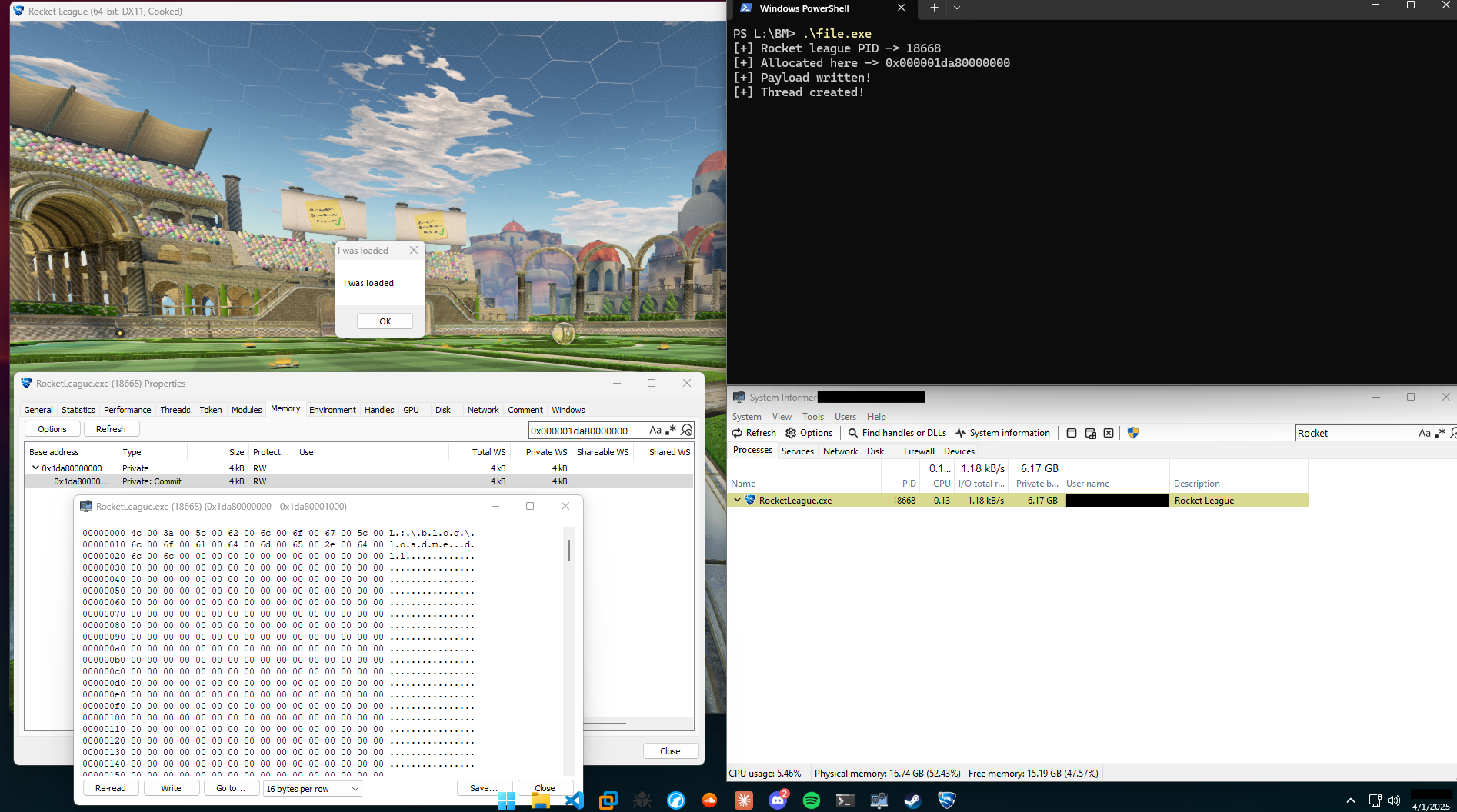
Remarks
This post was aimed towards beginners/people who know little about game hacking/game security and want to learn more. I am so fascinated by the idea that malware and cheats share the same techniques and I will continue to try and document the things I find to support that idea. Thank you for reading.
References
